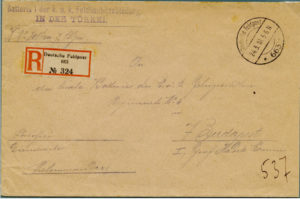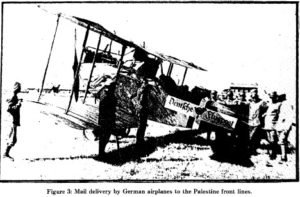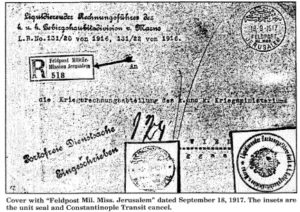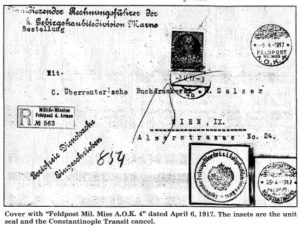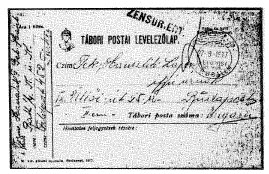World War I
Our Focus is Only on the Holyland (Palestine)
Postal Offices
Foreign Military
♦Other Central Powers
CENTRAL POWERS
German
German military support contingents, assigned to the Turkish forces from the beginning of World War I, had initially to rely for the handling of their correspondence exclusively upon the inadequate local Turkish postal system. To make matters worse, their mail was also subject to time-consuming censorship.
In order to alleviate these shortcomings and deficiencies, the “Field Post for Members of the Military Mission” was created. The former director of the German post office in Constantinople, major Hensel, was appointed as director of the new Field Post. Mail posted at Field Post Offices of the Military Mission was not subject to Turkish censorship. There were two such field post offices in Palestine, in the staging areas of Beersheba and in Jerusalem. Initially, date postmarks were used there with the name of the command post A.O.K.4 and 1. Expeditionskorps. These types of postmarks were later replaced with cancellers showing the location.
Prior to the establishment of the Field Post of the Military Mission in Palestine in May 1916, mail from German and Austro-Hungarian soldiers was brought by couriers to Constantinople and later to Aleppo, respectively, where it was processed.
http://www.alexandercollection.org/collection.aspx#collection=163
T
CENTRAL POWERS
German
T
T
T
German FPO registered letter from Nazareth to Budapest 1918
Description
Stampless registered letter sent from “Batterie 1 der K.u.K. Feldhaubitzabteilng – in der Turkei” (Battery 1 of the K.u.K. field Howitzer Detachment in Turkey” violet 2 line cachet at top left, to Budapest, German type registration label “R-Deutsch Feldpost-663-No 324” alongside, letter cancelled “Deutsche Feldpost – 663 – 24. 3. 18” postmark, in use in Nazareth 9 December 1917–20 September 1918. On back “Budapest” arrival postmark.
Date
24/3/1918
Markings
“Batterie 1 der K.u.K. Feldhaubitzabteilng – in der Turkei” violet 2 line cachet (Steichele 590.2)
“R-Deutsch Feldpost-663-No 324” German type registration label
“Deutsche Feldpost – 663 – 24. 3. 18” postmark (Steichele 281)
Place of Origin
Nazareth
Place of destination
Budapest
Object Type
Cover
Reg.Number
MHDA.0711.2012
Glossary
Field Post Office
Registered Mail
www.alexandercollection.org/collectionitem.
aspx#collection=173&item=2050250395&startitem=7
T
CENTRAL POWERS
German
(German Flying Corp. Mail)
T
Where are the image (s) of German Flight covers ACTUALLY FLOWN from World War I Holyland (Palestine)?
T
(1)
. . . it seems that only Staffel 300 was bought into action and became really operative in the field.
. . . The airstrips from which these Staffels operated were situated near Gaza, El Arisch and in some unknown
locality in the Sinai desert. . . . Later the Staffel moved to Jenin, south of the plain of Israel.
. . . Generally not very many letters and fieldpostcards are known. These bear the .Military Mission postmark, the name of the sender and its formation and in very few cases a special handstamped cachet, circular in shape with the in-scription “Deutsche Feldflieger, Abt. 300, Pascha,” an inner circle fills the Turkish inscription . . . .
GERMAN WINGS OVER PALESTINE IN WORLD WAR I. The Israel Philatelist, 1960, Vol 11, Issue 5, page 8 (113 – 114).
T
(2)
On 4 September 1918, the Foreign Ministry in Vienna notified the War Ministry that a flight line from Damascus to Nazareth was to be established with flights twice a week, delivering military news and the army journal Yilderim to headquarters in Nazareth, since delivery by railroad under prevailing conditions was subject to too much delay (Figure 2). A photo in the archives of the Smithsonian Institution in Washington shows a German double-decker with the insignia “Deutsche Luftpost”, German Airmail, and a posthorn. Next to the plane stand three men with a postal sack (Figure 3).
After searching for 20 years, I did find an example of the military German journal Yilderim, printed in Damascus, and delivered with the first flight to Nazareth. (Illustrated in Der Israel-Philatelist No. 101, page 3008).
The German Flight Detachment had its own postal hand stamp, Pascha 300. Supposedly, only six pieces of mail with this cachet are believed to have originated from Palestine.
THE GERMAN FLIGHT DETACHMENT IN PALESTINE IN THE FIRST WORLD WAR. The Israel Philatelist, 1989, December, pp. 5819 – 5821.
T
(3)
A flight detachment, the Feldflieger Abteilung 300, consisting of some nine planes and termed in short FFA 300, was established early in 1916. It was attached to the German Expeditionary Force, “Pascha,” its chief mission being supply and reconnaissance in support of the planned attack on the Suez Canal. In the course of the Turkish-German retreat, during the battles of 1917 and 1918 against the Allied Forces, the main quarters of the FFA 300 were situated at Samah on the southern end of Lake Tiberias. After the final attack by the Allies under General Allenby, Samah was lost on September 25,1918, and the detachment ceased to exist.
Four identifying cachets are known on mail originating from the FFA 300, although these do not necessarily confirm that all the mail was carried by air. Some of the mail was definitely carried by air, such as via the airmail service connecting the staff divisions at Damascus and Nazareth in early 1918.
http://www.alexandercollection.org/collectionitem.aspx#collection=174&overview=1
T
CENTRAL POWERS
German
(Austro/Hungarian)
T
The Turkish Army was reinforced and supplemented by German troops and supported by special Austro-Hungarian contingents. There was no Austrian Field Post Office in Palestine proper. Mail was sent from the Palestine front either to Constantinople (K. K. FPO No. 451) or to Aleppo (K. K. FPO No. 452) field post offices, which were organized in June 1917. It should be emphasized that the Austrian Field Post made considerable use of the German postal services. Many letters and postcards are found with Austrian unit cachets, but have been handled and postmarked by the German Military Mission Post, the regular German Army Field Post or the Turkish post. Austrian mail and unit cachets are preceded by the letters K. u. K. (Kaiserlich und Königlich, Imperial and Royal) and can thus be easily differentiated from cachets and markings of German postal origin. To ascertain the places of origin of Austro-Hungarian soldiers’ mail, it is necessary to consider troop-unit cachets and pay attention to events during the course of the war and the corresponding deployment of the various military contingents.
http://www.alexandercollection.org/collectionitem.aspx#collection=175&overview=1
T
CENTRAL POWERS
German
(Austro/Hungarian)
(Austrian)
T
. . . the Austrian (with no post offices) and the German military postal system in the Holy Land during World War I. With no post offices of their own the Austrians could send registered letters and had to use the German Postal Offices.
. . . .
These two covers were mailed by the paymaster of the MountainHowitzer Batterie v. Marno. Both 3-line cachets are the same differing only in size; one a bit longer and wider than the other. Both covers went through the German Military Postal System; one being cancelled Jerusalem Field Post Mil.(itary)
Miss.(ion) dated 18.9.1917 with the registration label “Feldpost Militar Mission Jerusalem 518.” It is addressed to the Division of the War Ministry in Vienna. On the back of the cover is the transit postmark of “Feldpost Mil. Miss. Constantinople 3.10.1917” as well as the seal of the artillery unit.
The second cover is also from Jerusalem; it has the postmark “A.O.K.4 (Army High Command 4) which was used by the General Headquarters in Jerusalem during the entire war. Its registration label reads, “Militar-Mission Feldpost 4 Armee Nr 563.” The cover is addressed to a commercial printing
press in Vienna and on arrival was not accepted as military mail and assessed postage due of 15 heller. No postage due was made for the registration of this letter as the clerk considered it the same as German and not Austrian. But he was wrong anyway. We see under the Austrian cachet the German word Bestellung” meaning that the letter contained a military order (for printing) therefore was strictly a military matter and post free.
Until last year only 16 such combination registered covers were know. I am quite sure that for many of you this field of military mail collecting would be fascinating. Pieces are always rare and a challenge to find since there were only 900 Austrian soldiers and military personnel in Palestine during World
War I.
TWO GEMS OF AUSTRIAN/GERMAN WORLD WAR I MILITARY MAIL IN THE HOLY LAND. The Israel Philatelist, Vol 49, Issue 1, February, 1998 page 17 (1998)
T
CENTRAL POWERS
German
(Austro/Hungarian)
(Hungarian)
T
Austro-Hungarian forces in Palestine, during World War I generally used ordinary postcards or envelopes for their mail. These sometimes had the unit
cachet applied. Recently a formula Field Post Privilege Card for Hungarian troops has come to light and is illustrated here. The card has the German Military Mission postmark dated 27th September 1917 and the Austro-Hungarian censor mark “Zensuriert.” This is the only example of such a card in Palestine I have recorded, also the same for George Muentz, the expertiser and Doyen of Holy Land Philatelists.
HUNGARIAN FIELD POST PRIVILEGE CARD USED IN PALESTINE 1917. The Israel Philatelist, Vol 46, Issue 11-12 page 30 (7424).

